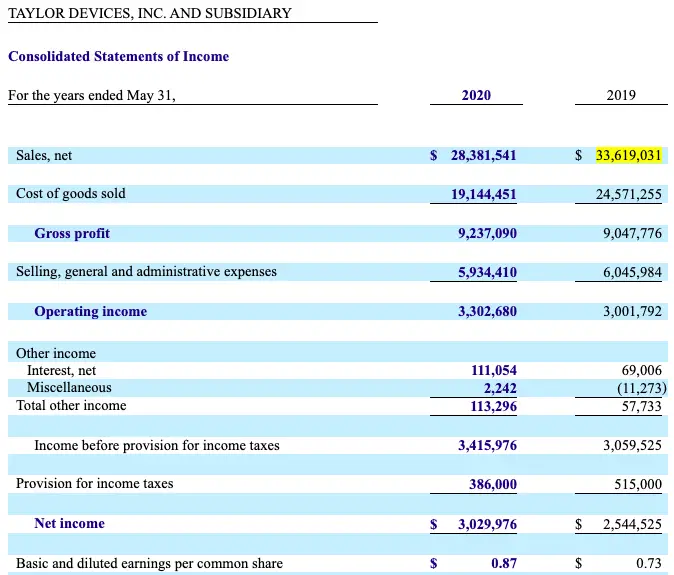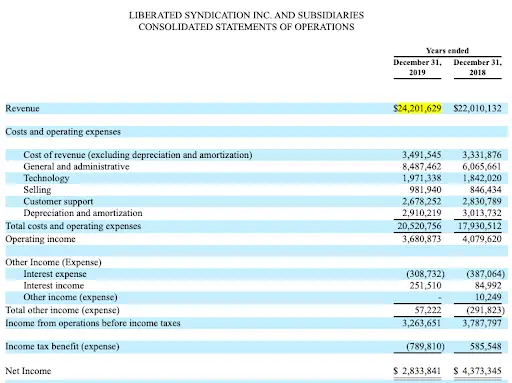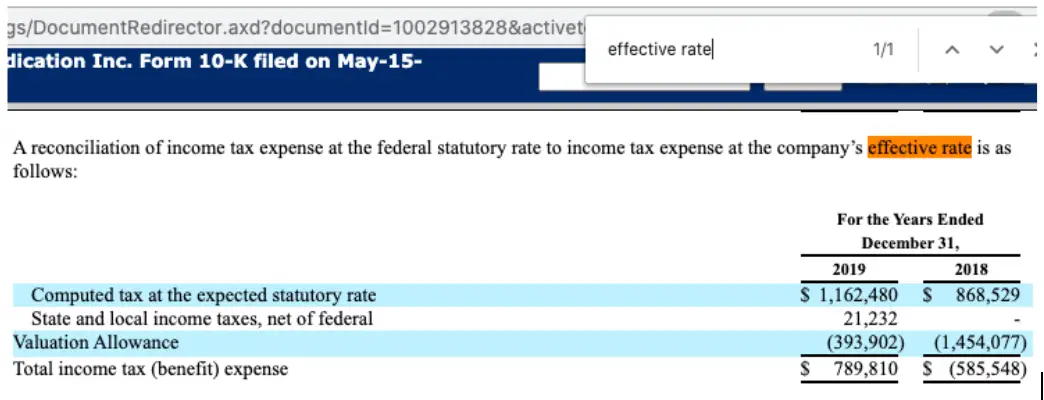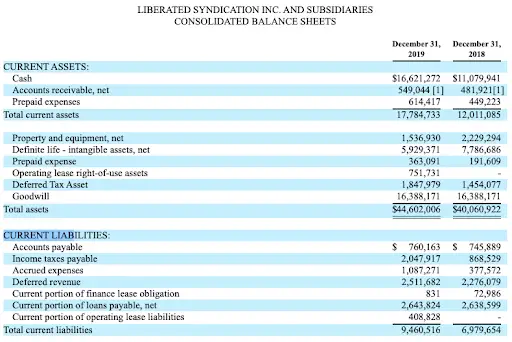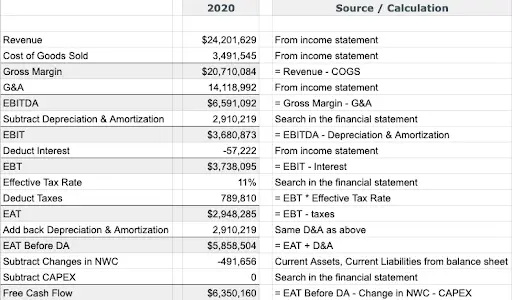Free cash flow is the best indicator of how much true cash is flowing into the company net of all cash out-flow.
It’s basically cash flow after taxes and after you’ve paid all cash payment obligations.
There are several ways to calculate free cash flow. You can start from net income, you can start from cash flow from operations, etc.
In my investment days of calculating free cash flow when building DCF valuation for company after company, below are the 4-steps I always took to calculate free cash flow.
Step 1: EAT!
First, calculate Earnings Before Taxes (EBT) and deduct taxes to get Earnings After Taxes (EAT)
| Revenue | $1,000,000 |
| Cost of Goods Sold | ($500,000) |
| Gross Margin | $500,000 |
| G&A | ($300,000) |
| Earnings Before Interest, Taxes, Depreciation & Amortization (EBITDA) | $200,000 |
| Subtract Depreciation & Amortization | ($50,000) |
| Earnings Before Interest, Taxes (EBIT) | $150,000 |
| Deduct Interest | ($10,000) |
| Earnings Before Taxes (EBT) | $140,000 |
| Deduct Taxes (let’s say 35% of EBT) | ($49,000) |
| Earnings After Taxes (EAT) | $91,000 |
We apply taxes after interest because you don’t pay taxes on interest payments.
Step 2: Add Back D&A
Once you have EAT, add back Depreciation & Amortization since it’s a non-cash expense that we subtracted earlier.
| Earnings After Taxes (EAT) | $91,000 |
| Add back Depreciation & Amortization | $50,000 |
| EAT Before DA | $141,000 |
Step 3: Subtract Changes in Non-Cash NWC
The next step is to subtract changes in Net Working Capital (NWC).
For free cash flow, we want to calculate non-cash net working capital.
What is Net Working Capital (NWC)?
NWC is simply current assets – current liabilities on the balance sheet. Current assets include inventory, accounts receivable, cash & cash equivalents, etc.
Non-Cash Current Assets
Since, we need non-cash net working capital, we only need the non-cash current assets.
Non-cash current assets are inventory, accounts receivable, and prepaid expenses.
Non-Cash Current Liabilities
Current liabilities include accounts payable, short-term debt balance, etc.
Again, since we want non-cash net working capital, we take the non-cash current liabilities, which are accounts payable and other accrued expenses.
Changes in Non-Cash Current Assets
Changes in current assets is calculated by taking this period’s non-cash current assets and subtracting it by the previous period’s current assets.
When you have the changes in current assets, you’re calculating how much cash went up or down in the current asset accounts.
For example, if Accounts Receivable (which is a current asset) went down, that means you were able to collect some cash that was invoiced.
Changes in Non-Cash Current Liabilities
Changes in current liabilities is taking this period’s current liabilities and subtracting it by the previous period’s current liabilities.
Similarly, when you have changes in current liabilities, you’re calculating how much cash went up or down in the current liabilities accounts.
For example, if Accounts Payable (which is a current liabilities account) went down, that means you paid the suppliers some amount you were invoiced.
Changes in Non-Cash Net Working Capital
Changes in net working capital then is when you put the above together; i.e.:
- Changes in NWC = [Last period’s Current Assets – Current Liabilities] – [This period’s Current Assets – Current Liabilities]
In the simple example then, that is:
| EAT Before DA | $141,000 |
| Subtract Changes in NWC | $10,000 |
Step 4: Subtract CAPEX
The last step is subtracting the capital expenditure (CAPEX).
This can be found on the balance sheet by taking this period’s Property, Plant & Equipment (PPE) line item minus the previous period’s.
Or, it can be stated in the financial statement along with an explanation of what it was spent on during that period.
Here’s an example from Taylor Device’s annual report:
Putting it together in our simple example:
| EAT Before DA | $141,000 |
| Subtract Changes in NWC | $10,000 |
| Subtract CAPEX | ($30,000) |
| Free Cash Flow | $101,000 |
Calculation of Free Cash Flow Putting it Altogether
Pieced altogether, the simple free cash flow calculation table is:
| Revenue | $1,000,000 |
| Cost of Goods Sold | ($500,000) |
| Gross Margin | $500,000 |
| G&A | ($300,000) |
| Earnings Before Interest, Taxes, Depreciation & Amortization (EBITDA) | $200,000 |
| Subtract Depreciation & Amortization | ($50,000) |
| Earnings Before Interest, Taxes (EBIT) | $150,000 |
| Deduct Interest | ($10,000) |
| Earnings Before Taxes (EBT) | $140,000 |
| Deduct Taxes (let’s say 35% of EBT) | ($49,000) |
| Earnings After Taxes (EAT) | $91,000 |
| Add back Depreciation & Amortization | $50,000 |
| EAT Before DA | $141,000 |
| Subtract Changes in NWC | $10,000 |
| Subtract CAPEX | ($30,000) |
| Free Cash Flow | $101,000 |
Free Cash Flow Calculation Company Examples
Let’s look at some examples using public companies’ financial statements.
First, we’ll look at Taylor Devices and second, we’ll look at Liberated Syndicated.
Free Cash Flow Calculation Company Example: Taylor Devices
The first example company is Taylor Devices, which is a microcap industrial machinery company based in New York that’s been around for 60 years.
I first collect the company’s income statement, capex, tax rate, depreciation & amortization, and current assets & current liabilities from their financial statement filings as follows.
Income Statement:
Depreciation & Amortization:
Search for the term “depreciation” in the financial statement to look for a paragraph telling you the amount.
Capex:
Same as Depreciation & Amortization, search for the term “Capital expenditure” in the financial statement to look for the paragraph that tells you the amount.
Tax Rate:
Also, search for the term “tax rate” to look for the actual effective tax rate they expect to pay.
You will need this to calculate the tax from EBT.
Net Working Capital (Non-Cash Current Assets & Current Liabilities):
As explained above, to get the non-cash net working capital, we must get the current assets and current liabilities.
Grab the balance sheet from the financial statement. 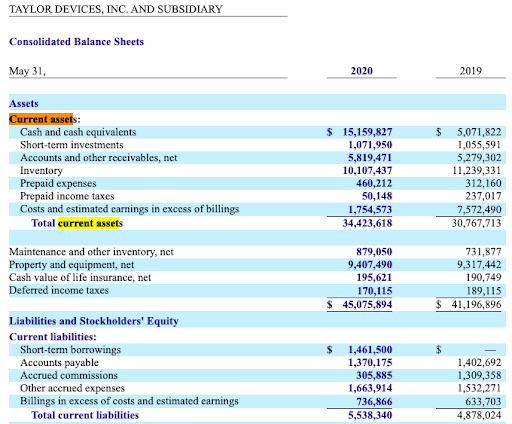
Free Cash Flow Calculation in FY20 for Taylor Devices
With the above information gathered from the company’s annual report filing, now we can put together the free cash flow calculation:
Free Cash Flow Calculation Company Example: Liberated Syndication
Cool, let’s look at another example company’s free cash flow calculation.
This time, we’ll pick another microcap company but in an entirely different industry.
We will use Liberated Syndication (LibSyn) as an example company. It’s a podcast hosting platform company that’s been around since 2004.
Again, let’s gather the info from their FY19 annual report filings (since their FY20 ends in December 2020 calendar year).
Income Statement:
Depreciation & Amortization:
CAPEX:
There’s no capital expenditure for LibSyn in this annual report. No worries.
Sometimes, due to the nature of the company’s operations, there are no capital expenditures.
Tax Rate:
Unlike Taylor Devices, LibSyn’s annual report doesn’t state the effective tax rate.
Instead, it shows us the amount of taxes paid. That’s useful nonetheless. There are different flavors of lemonade.
Net Working Capital (Non-Cash Current Assets & Current Liabilities):
Finally, grab the balance sheet for our precious net working capital calculation.
Free Cash Flow Calculation in FY19 for LibSyn
Now, time to put it altogether again and calculate the free cash flow.


